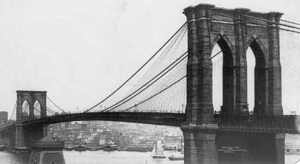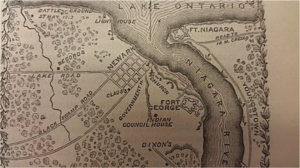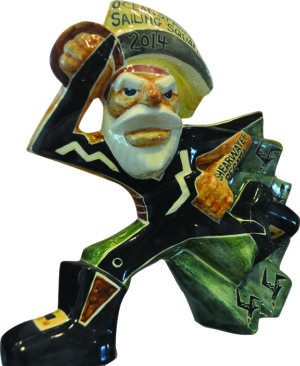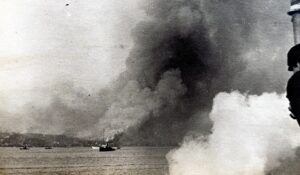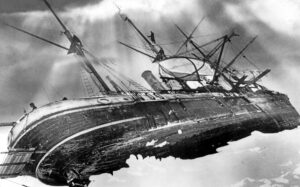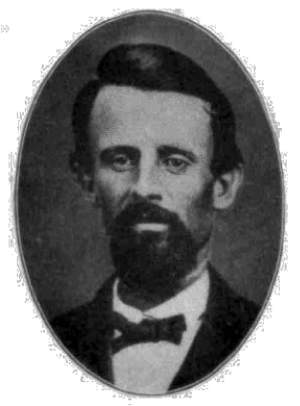January: A time to look forward — and back. Whether you call it a “Change of Watch” or “Change of Command” or “Passing the Gavel,” January is the month of rebirth in the world of clubs and associations. The name of the month is taken from the Roman god Janus, the protector of gates and doors, as well as beginnings and endings. Romans believed that in return for his hospitality to the great god Saturn, Janus was given the ability to see both the future and the past; and so he was depicted in their culture with two faces, one looking back and the other looking forward. Since ancient times, the month of January has been seen as a bridge between the old and the new. It may be only a coincidence, but construction of the greatest icon of all American bridges began on January 3, 1870. Although it would take another 13
Read More
The Friendliest of Enemies
In an era of all-out-give-‘em-hell war, it’s nice to think about the days of yore when armed disputes between nations were put in the hands of gentlemen—mostly “second sons”—who, after they had done their duty and covered themselves in glory, were eligible to marry gracious young women with titles like “Lady,” and set about raising a brood of children for the next generation. Well, maybe it didn’t happen that way exactly, but it’s nice at least to contemplate such legends. One of those legends involves the battle between the hurriedly-constructed Fort George located on the Canadian side of the Niagara River and Fort Niagara, a stone fortress begun by the French in 1687, captured by the British in 1759, and lost to the Americans in the treaty that ended the Revolutionary War. The story goes that British and American military officers had much more in common with each other than
Read More
Trophies
A club’s trophies serve two important functions: in addition to being awards for current contests, they are a daily link with the club’s history. Yacht club trophies may come in many shapes and sizes, but the one thing they should not be is a mass-produced, multi-columned, wedding-cake-top affair with the ubiquitous figure of a small human being holding a torch, a globe, a golf club or anything else. Yacht club trophies have been fashioned from glass or ceramic objects of art, and some clubs have trophies that were custom-made from binnacles or cannons. St. Petersburg Yacht Club (Florida) has a trophy that is awarded annually to the winner of the Royal Gaboon Race. The trophy is made from a silver cuspidor said to have been “liberated” in 1948 from a notorious New Orleans “establishment.” The club will not reveal the exact nature of the es-tablishment, but explains that “gaboon” is
Read More
Folding the Flag
Just in time for Flag Day and the Glorious Fourth! Many traditions surround the American flag; among them is the proper method of folding the flag before storing it or presenting it at a ceremony. Regardless of size, it takes thirteen folds to properly fold our Nation’s flag: two lengthwise folds and eleven triangular folds. Some people have found significance in that fact, linking the number 13 with the thirteen original colonies, and they have attempted to attach a special meaning to each fold. In fact, the flag is folded thirteen times in order to achieve a compact and pleasing result; the number 13 is coincidental. Several people have written “Thirteen Folds” ceremonies meant to be read while the folding process is taking place. Lt. Col. Samuel Hudspath, Chief of Protocol of the United States Air Force, who has researched the subject, has written: There is no shortage of scripts
Read More
The Problem with Mixed Signals
Mixing signals in your club, your business, or—for that matter—your marriage, does not work. To be successful at anything you have to choose one course and stay on it. History is full of examples of tragedies that resulted from mixed signals, but few are more horrific than that which befell the City of Halifax, Nova Scotia, when the entire city was obliterated in the blink of an eye. On December 6, 1917, the French ship Mont-Blanc was entering Halifax harbor loaded with 62 tons of gun cotton, 150 tons of TNT, 2,366 tons of picric acid (which was even more unstable and powerful than TNT), and, finally, 246 tons of benzol that was packed in steel drums stacked four high. In all, the ship was loaded with six million pounds of high explosives that the French government purchased from its New York agents and which were being shipped to France
Read More
A Dramatic Lesson in Leadership – Part 2
Last month we traced the course of the ill-fated Donner Party as their wagon train attempted to cross the Sierra-Nevada mountains and reach a place they considered to be paradise: it was California. After being stuck for three months in cabins near Lake Truckee, 44 of the 89 emigrants did reach “paradise”—but it wasn’t the one they expected. Those poor souls died of disease and starvation in spite of the fact that they had some supplies including a few horses and cattle, endless firewood, and a trout-filled lake. They were on a well-known trail and had to do little more than “shelter in place” for four months until they would be rescued. But, because of the indecisive leadership and mistakes of George Donner, half of the party died. Contrast that with the trans-Antarctic expedition led by Sir Ernest Shackleton. Their ship, the Endurance, was caught in the ice on January
Read More
A Dramatic Lesson in Leadership
On February 19, 1847, the first members of the Donner Party were rescued from their snowbound prison in the icy Sierra-Nevada Mountains. Their story is one of mismanagement and indecisiveness. It vividly contrasts with the story of the Shackleton Expedition and provides a dramatic lesson in leadership. George Donner and his family were part of a wagon train of settlers headed for California. George was elected leader of that train, not because of his experience or his ability to inspire, but because he was the richest man. The settlers set out from the usual jumping-off place of Springfield, Illinois, in April, 1846. Their pace was slow because every time an important decision had to be made, George would order the wagons circled, hold a meeting and determine the wishes of the majority. In spite of the constant delays, by that summer the emigrants reached Fort Bridger, Wyoming. While there they
Read More
Freezing the Balls off a Brass Monkey
The story goes that cannon balls on British ships were stored on deck in pyramidal-shaped brass stands called “monkeys.” They say that in cold weather, the brass would expand faster than the iron balls, causing the balls to fall off and roll around the deck creating havoc for the crew. Thus came the expression, “Cold Enough to Freeze the Balls Off a Brass Monkey.” A moment or two of rational thought proves the story cannot be true. Deck space on sailing ships is very limited; no captain in his right mind would allow cannon balls to take up valuable space because they made an attractive display. And what kind of fool would store iron cannon balls on brass stands? Cannon balls are heavy objects weighing anywhere from 4 to 42 pounds; they had to be tightly secured so as not break loose in heavy weather. In fact, cannon balls were
Read More
Jolly Old Saint Nick – the Sailor’s Friend
Every December we’re swamped with images of America’s greatest salesman – Santa Claus – hawking everything from fast food to automobiles. In the deluge of media hype, there are always a few stories reminding us that the idea of “Santa Claus” evolved from St. Nicholas, and one or two of those stories might go so far as to explain the real Nicholas was a kindly bishop of Myra (today known as Demre and located in modern-day Turkey). But how many people know that St. Nicholas is also the patron of sailors and ships, offering safe voyage and protection from storms? The Legend of St. Nicholas begins with a poor family of Myra who could not provide dowries for three daughters. Since the girls were unable to marry, they would have to be sold into slavery. It is said that Nicholas saved the day by riding past the house late at
Read More
What is the correct arrangement of flags on the Yacht Club masthead?
A Reader writes: “I’m so mad I want to quit our club! Our Commodore insists on flying our country’s flag lower than the club burgee. It looks bad and it’s wrong, but he says the gaff is the “place of honor.” He says he learned it at “the Academy.” What is the place of honor? And what “Academy” is he talking about?” The flag display at all maritime locations—naval installations, Coast Guard bases, ports, yacht clubs, and even the United States Naval Academy—all have one thing in common: a gaff extending upwards off the “back” of the flagpole at about a 45% angle. The top of the gaff is the “place of honor.” Here’s why: The maritime flag display represents a sailing ship “standing out to sea.” In other words, when you see that display with the yardarm and the gaff, you’re looking at a sailing ship about to leave
Read More

